Презентация Week 9 Exchange rate and BOP

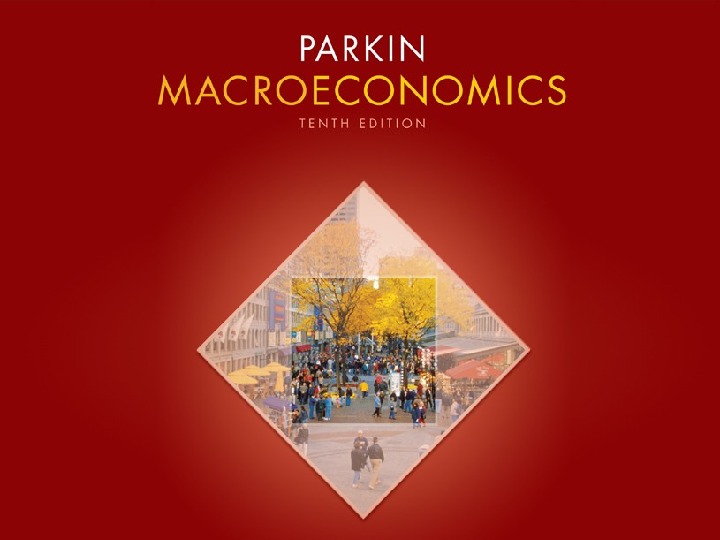
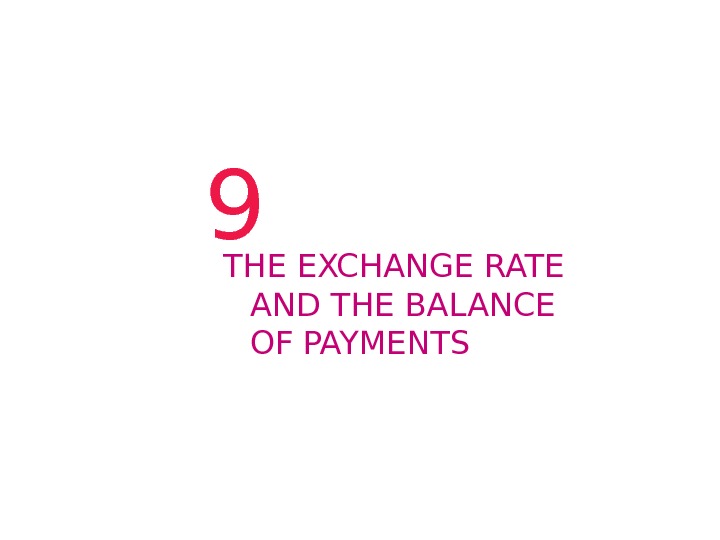
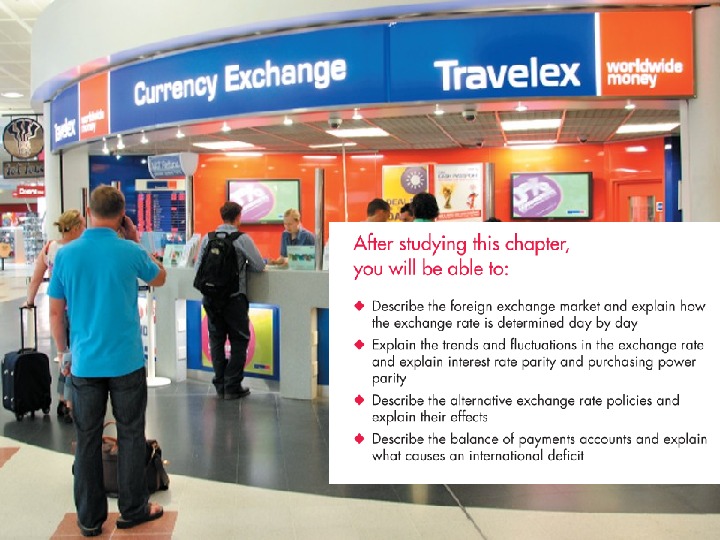
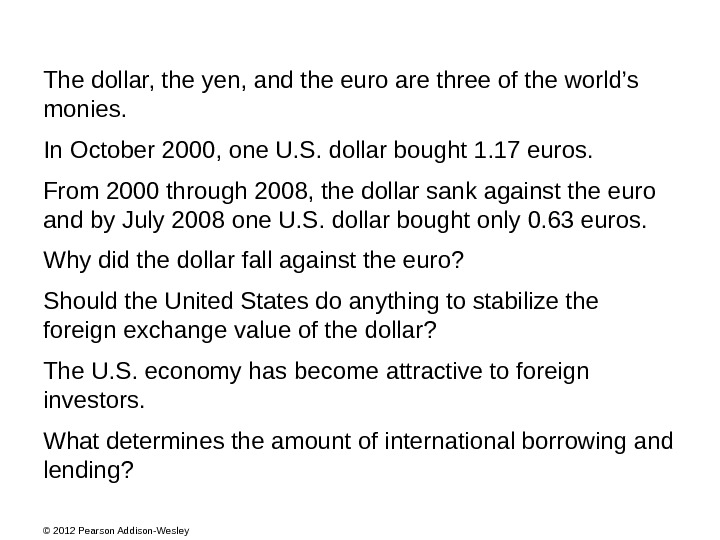
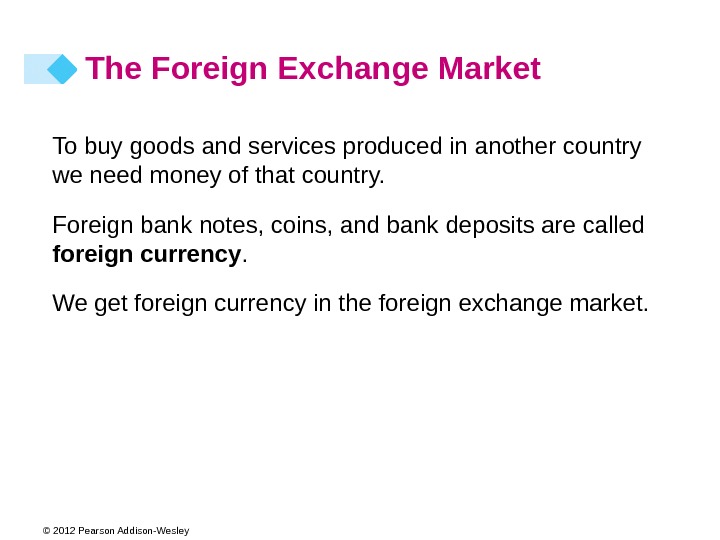
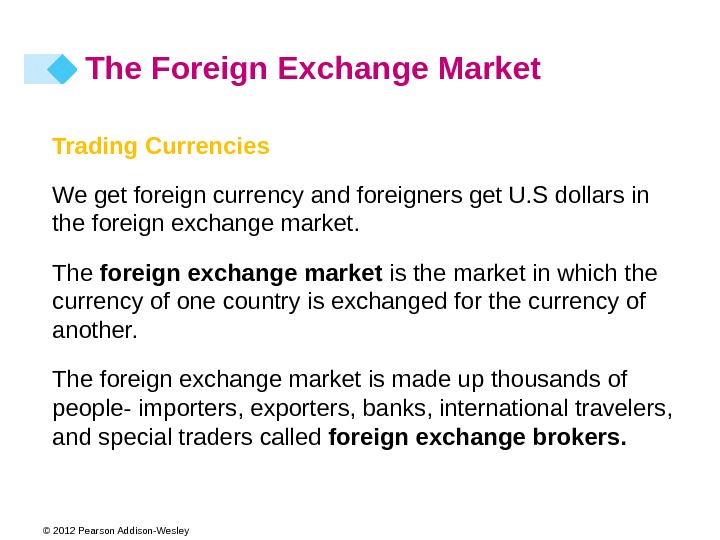
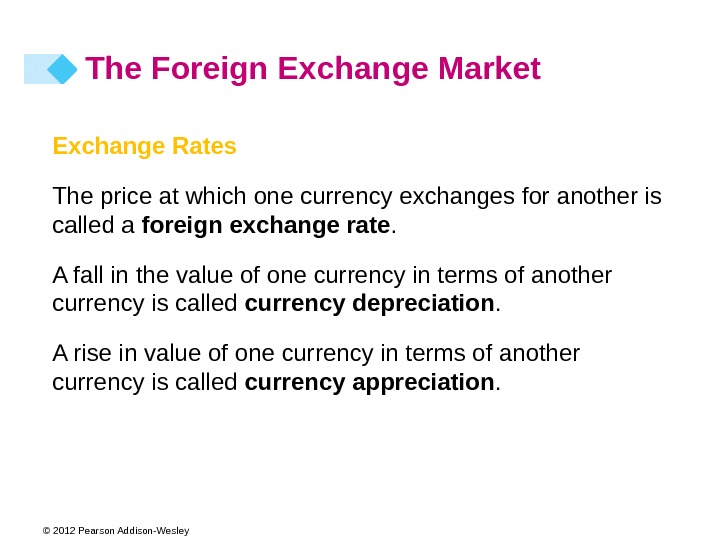
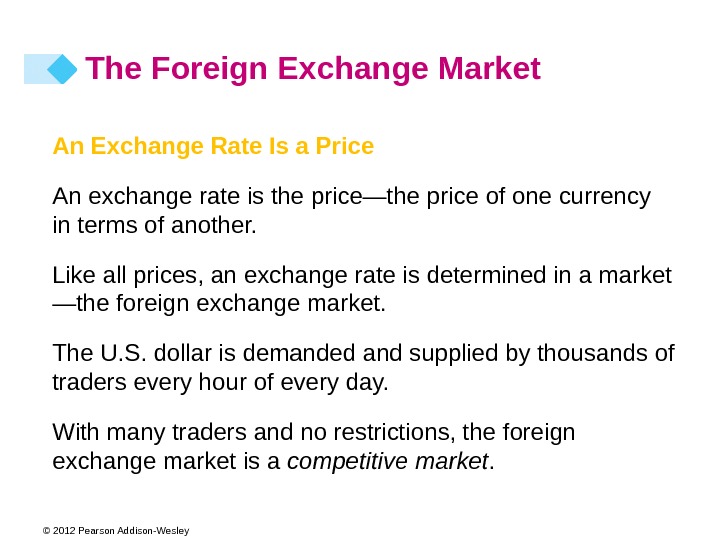

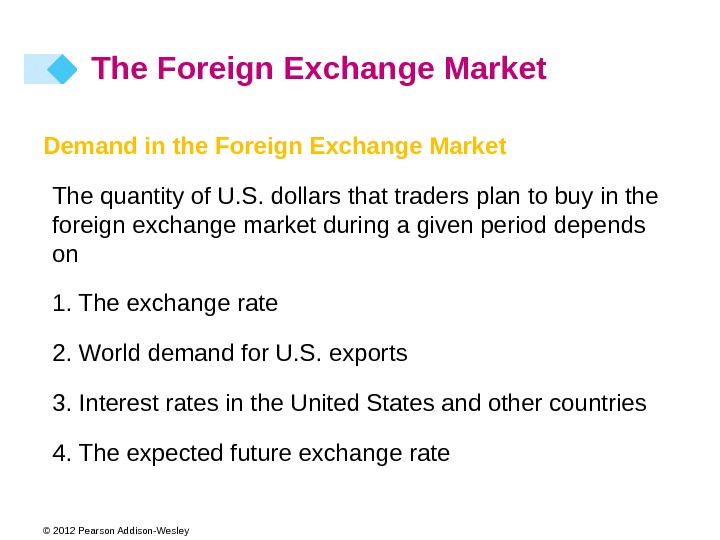

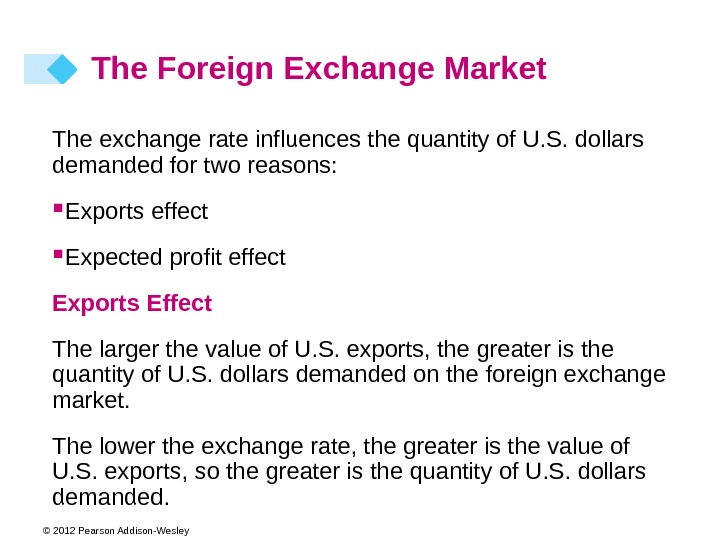
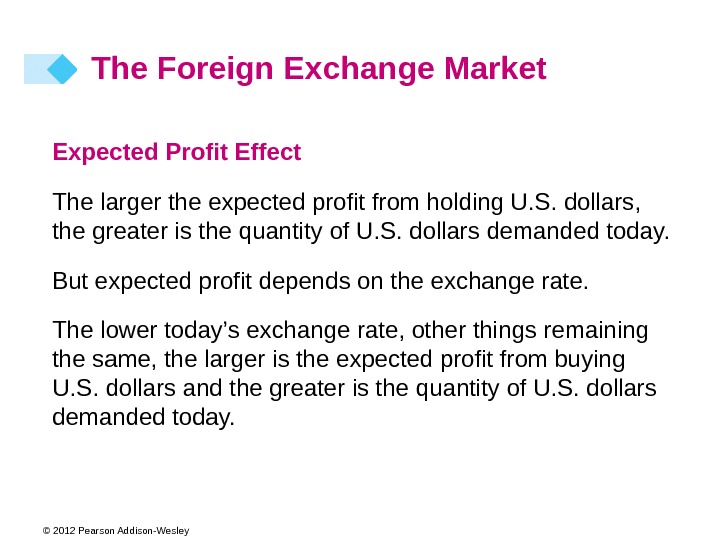

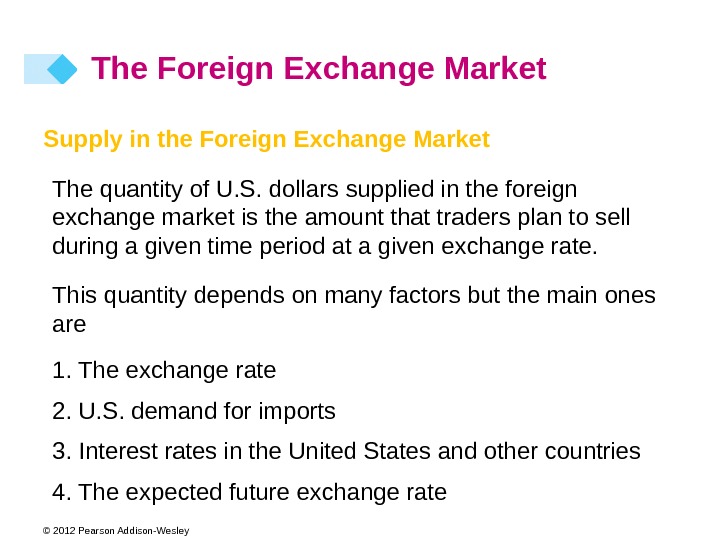
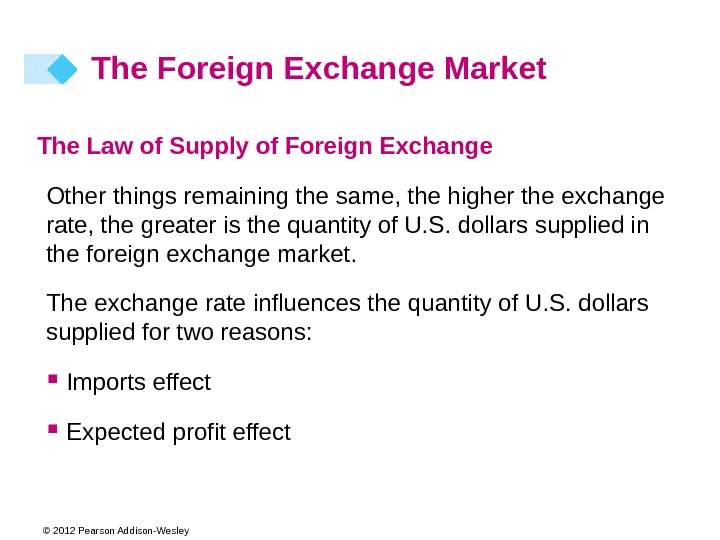

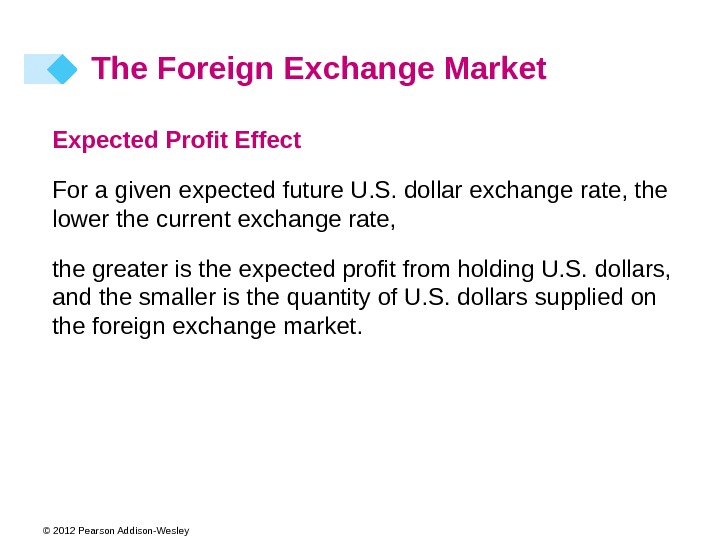
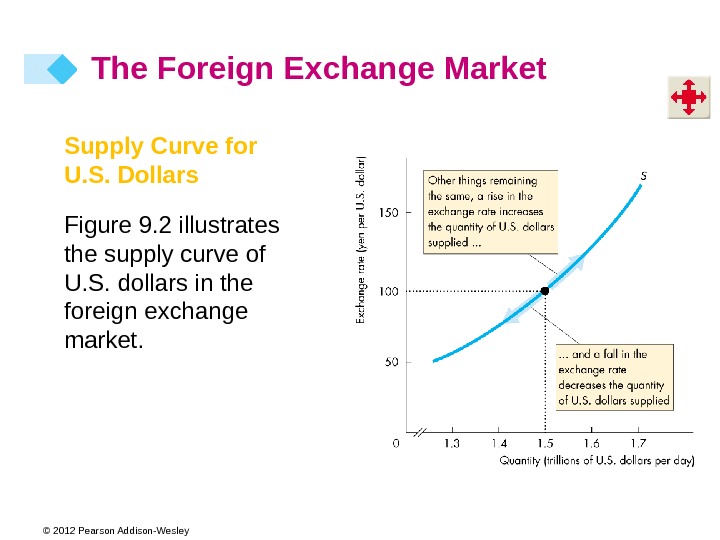

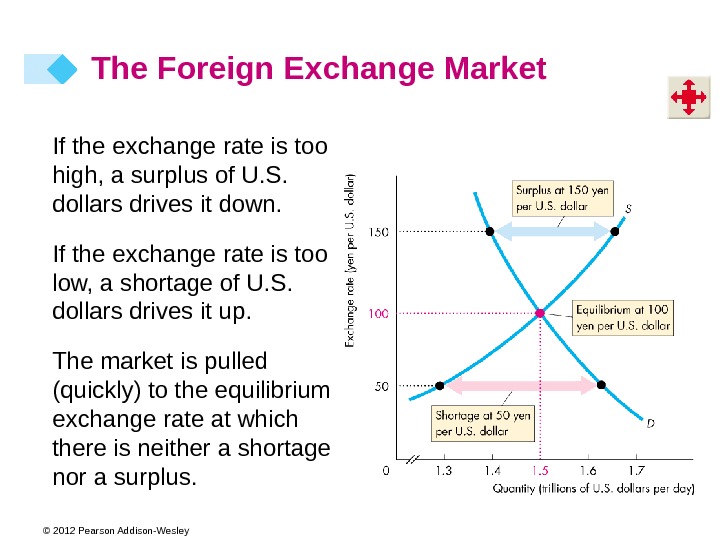
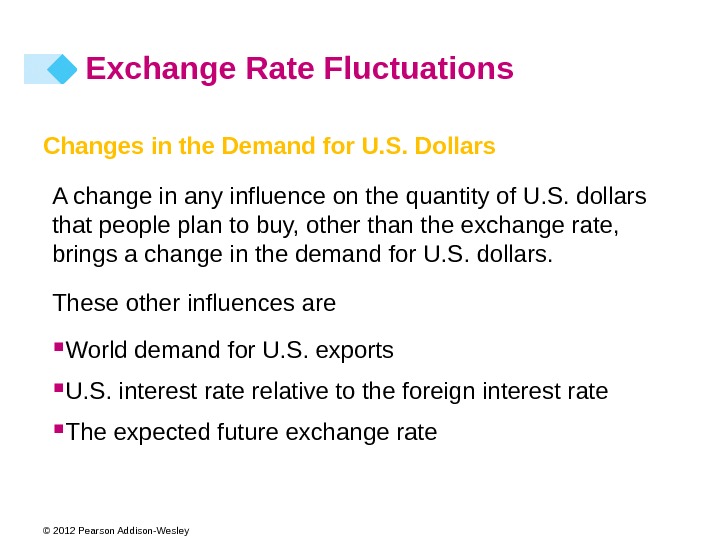
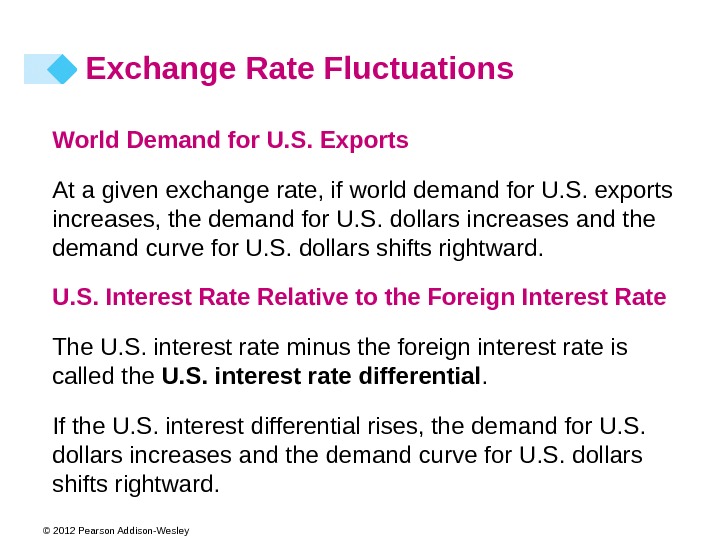
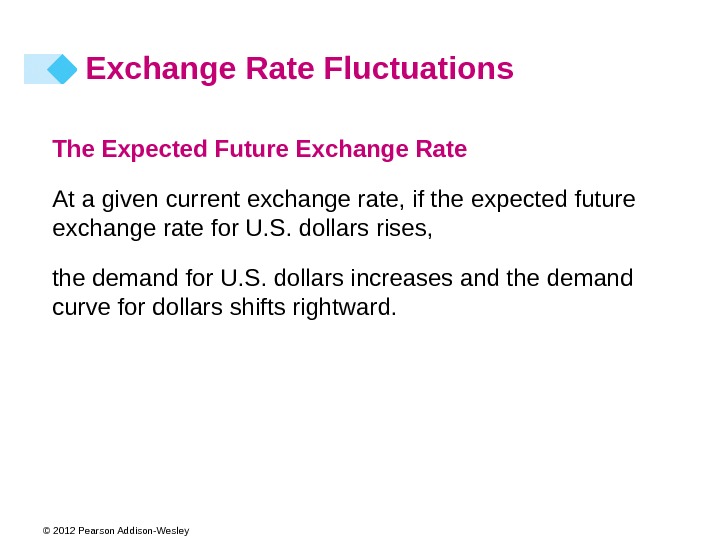
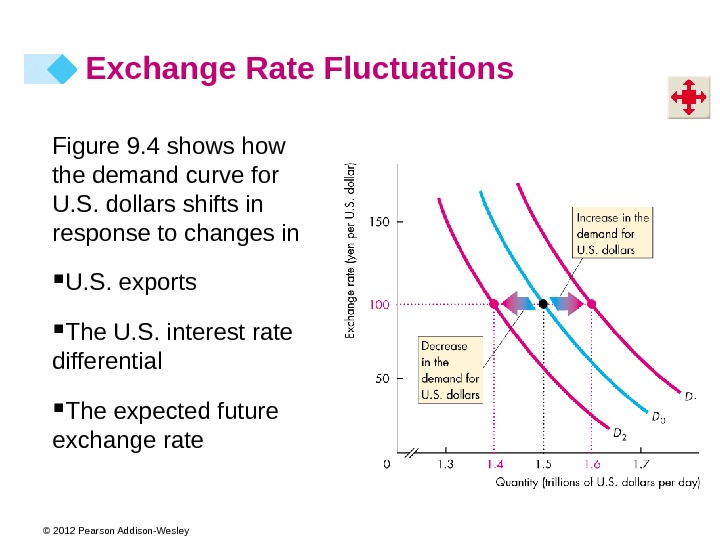
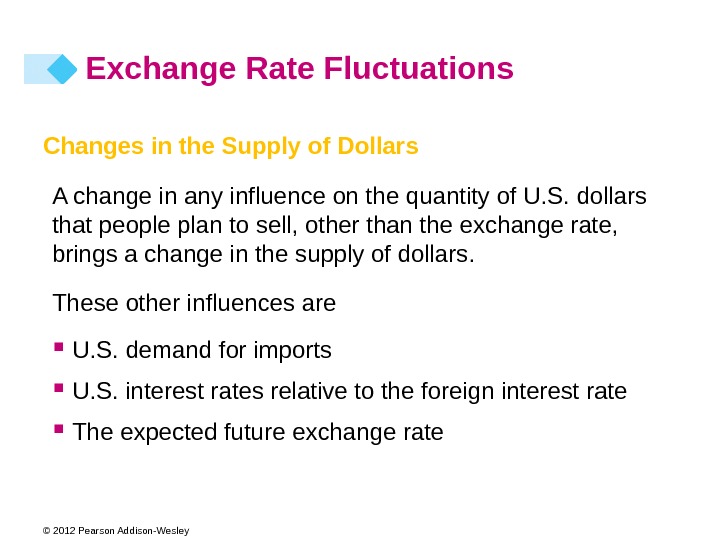
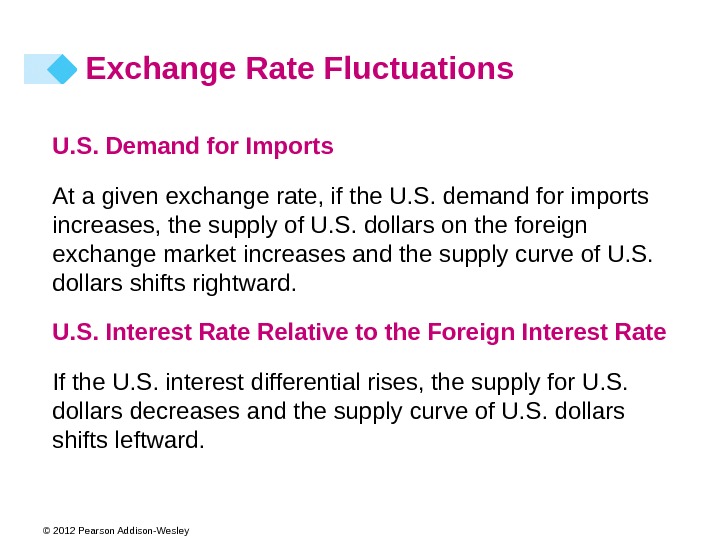
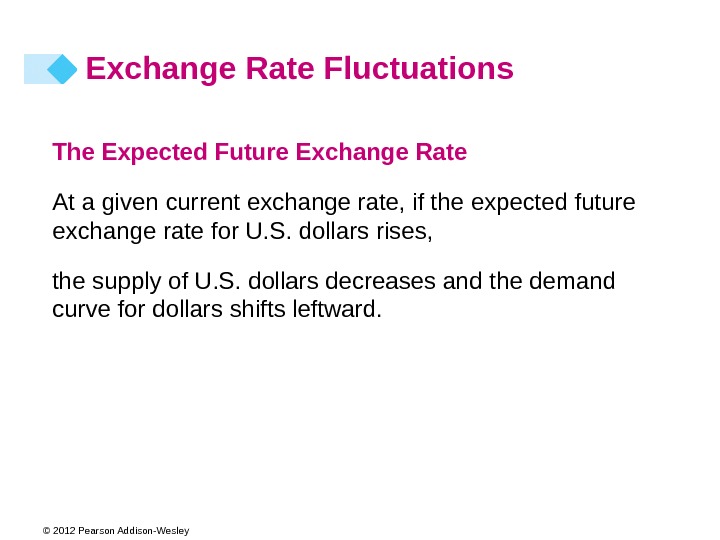
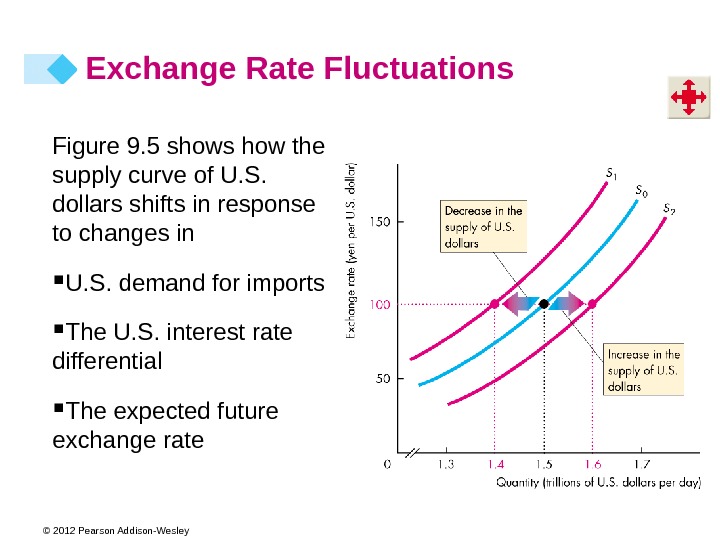
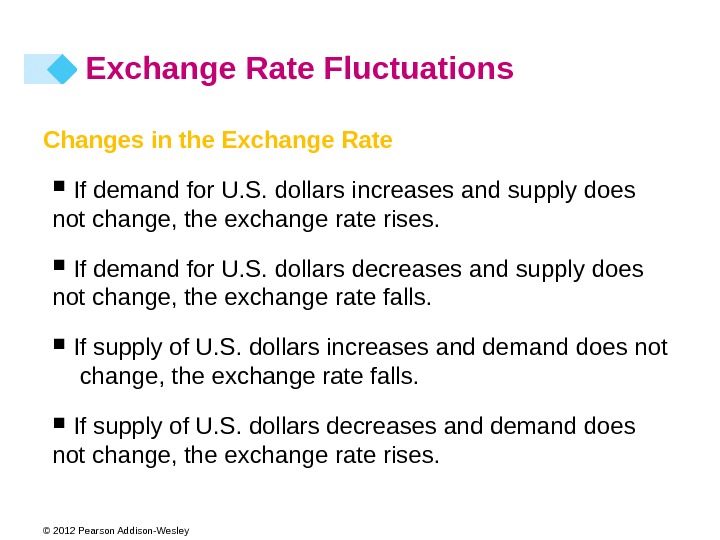
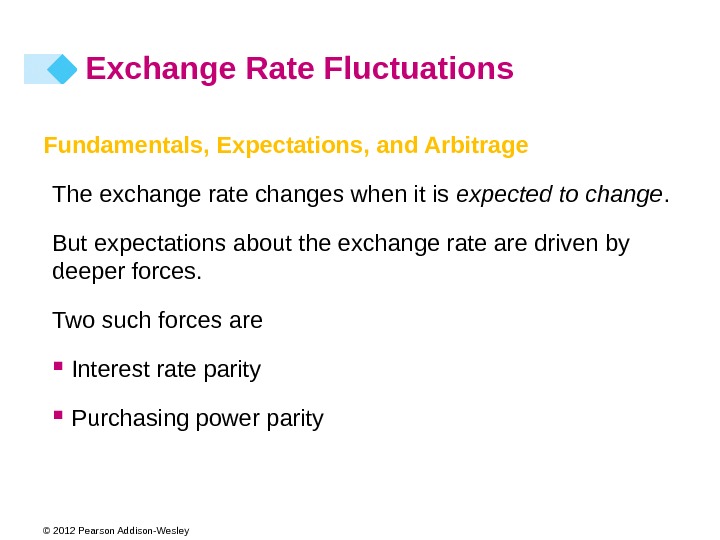
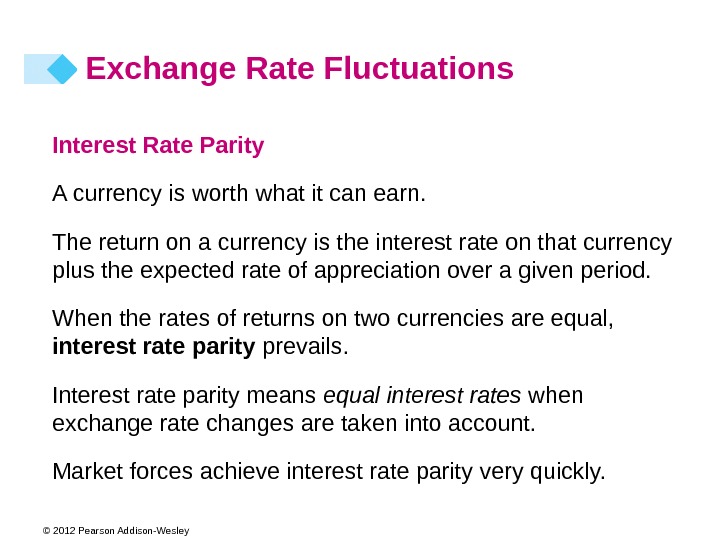
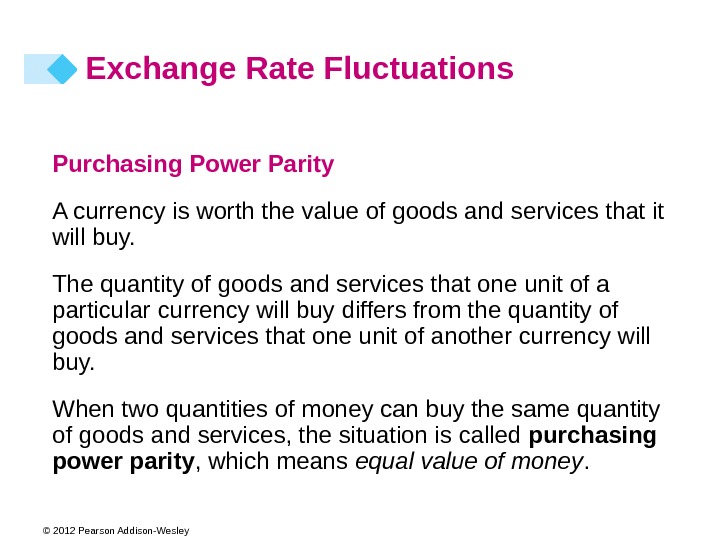
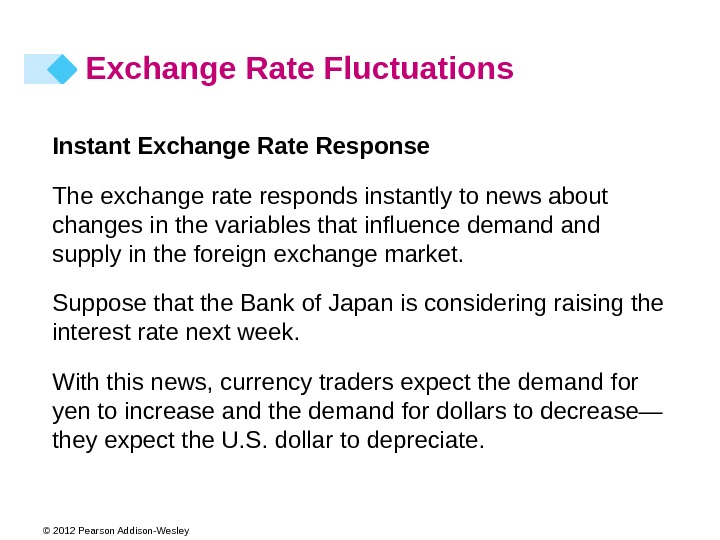
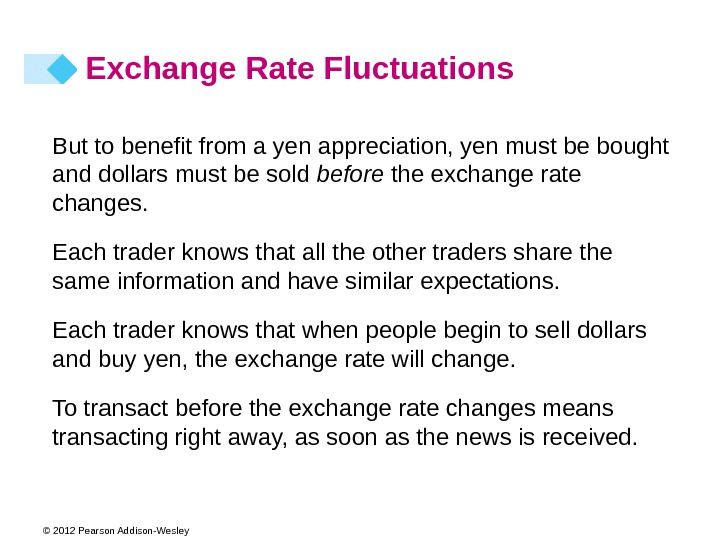
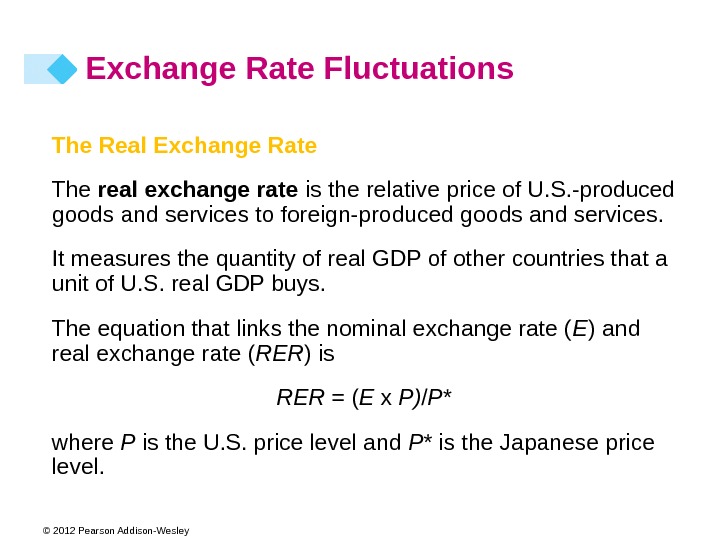
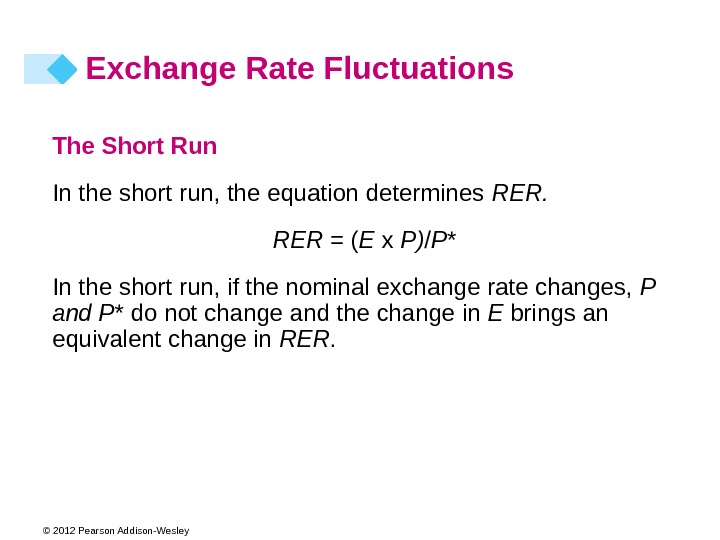
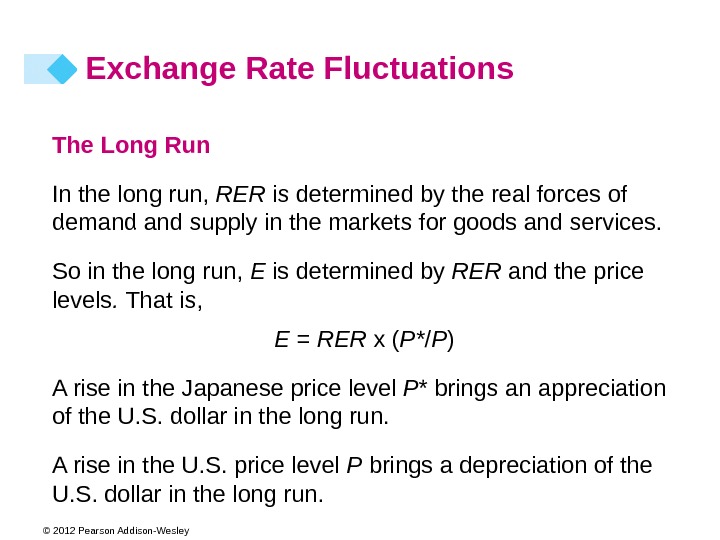
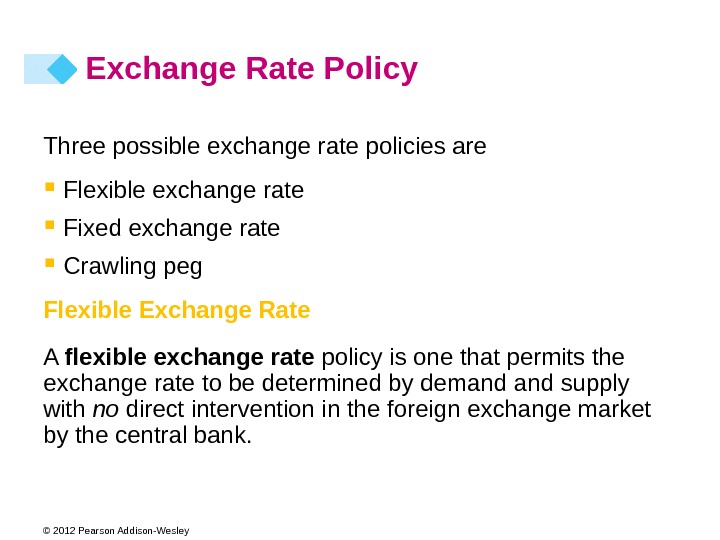
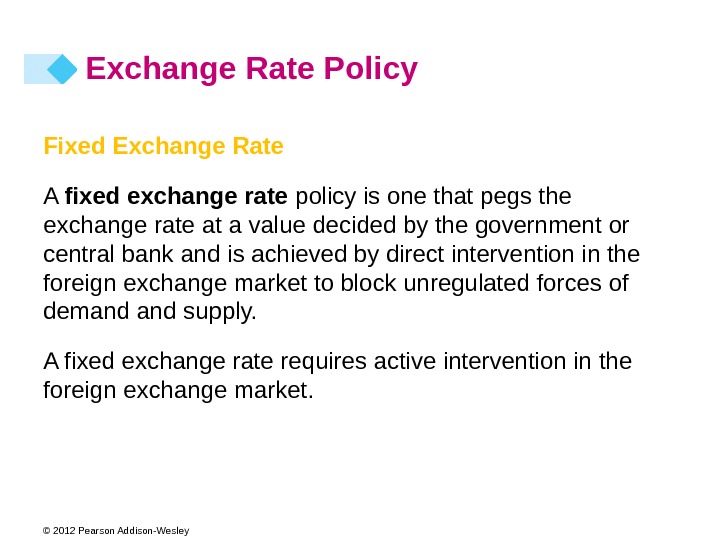
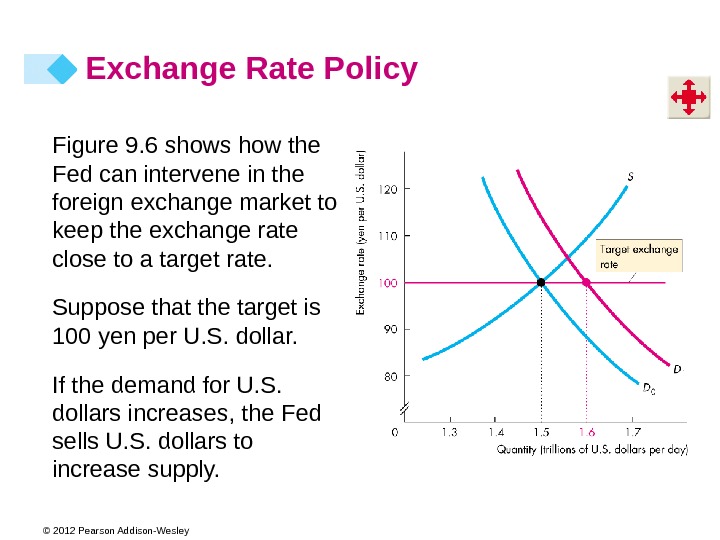
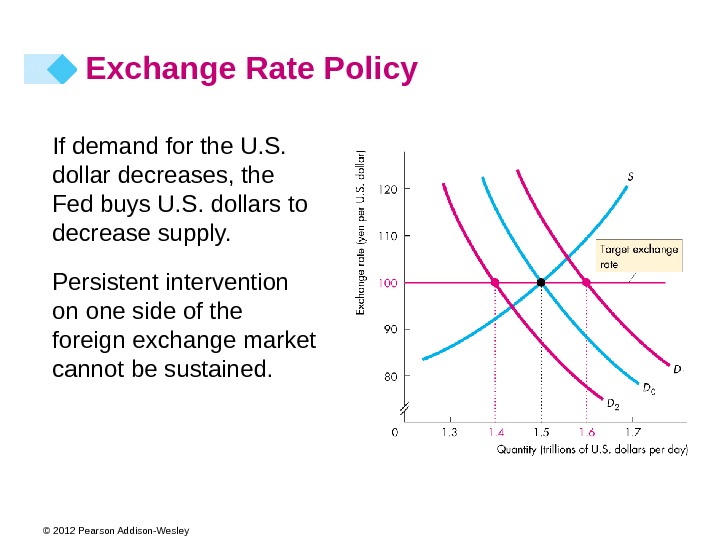
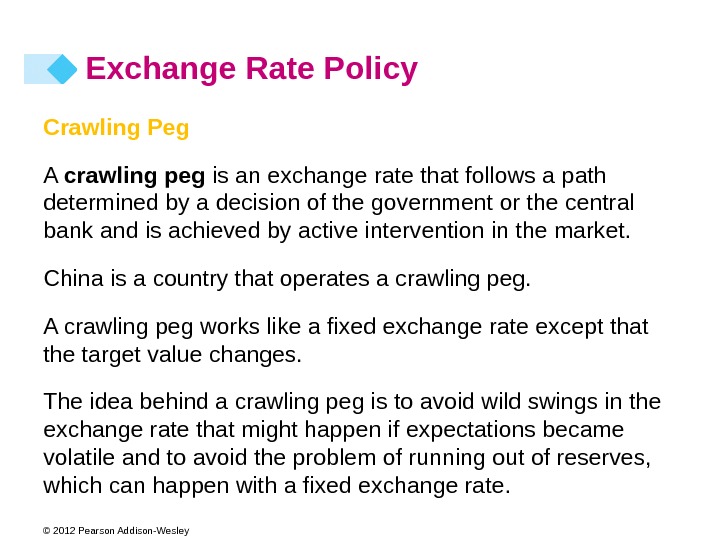
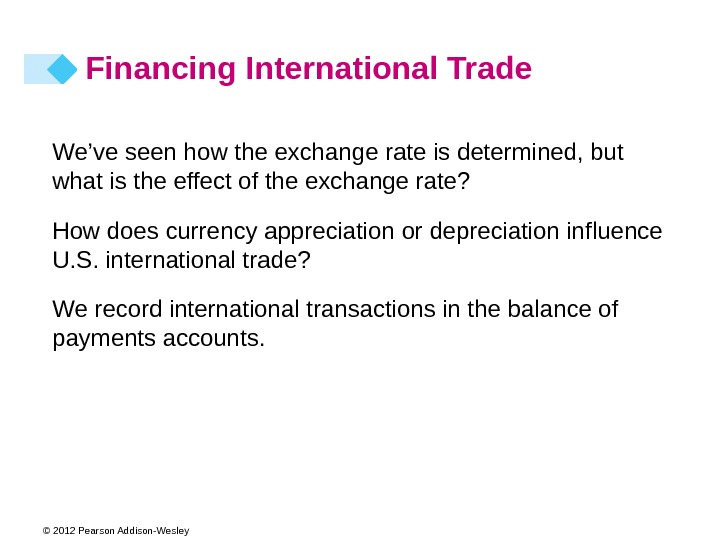
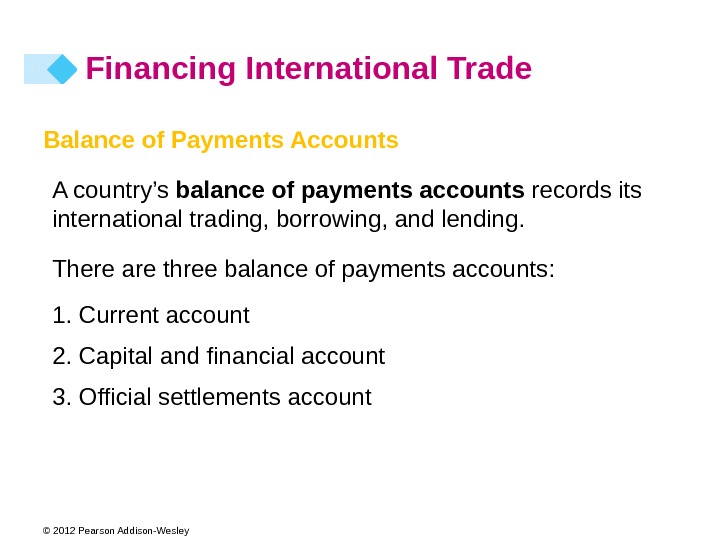

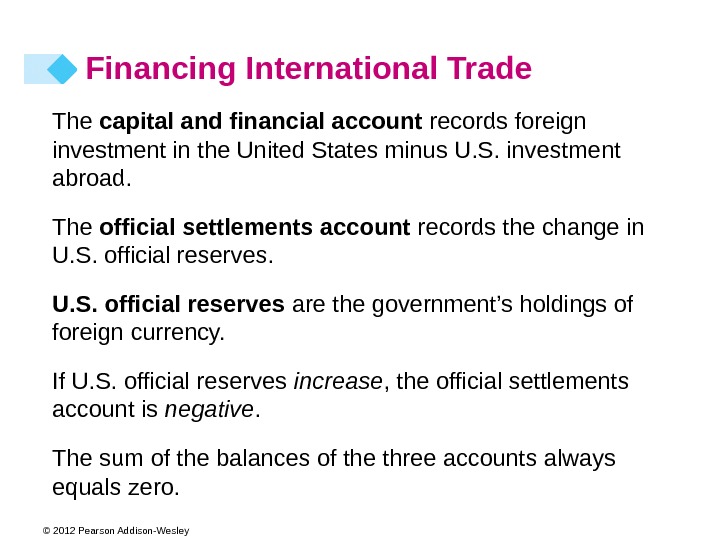

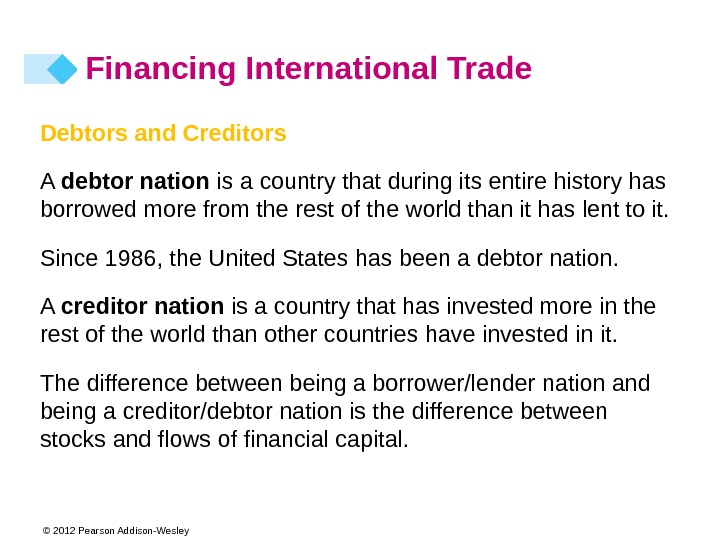
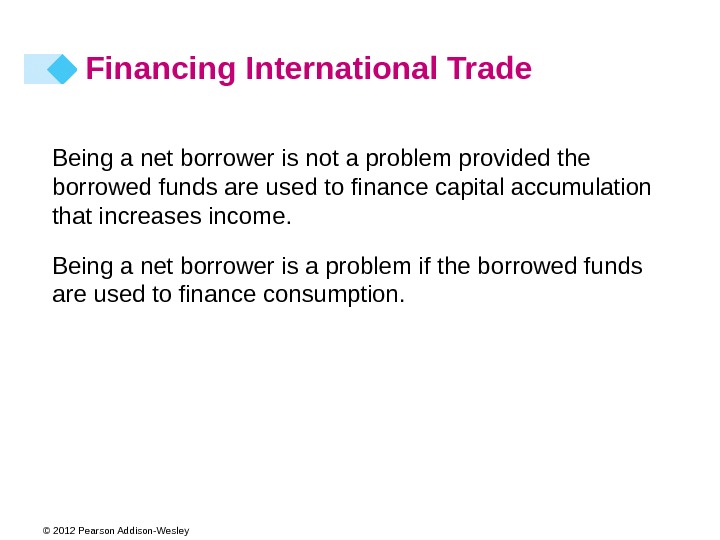
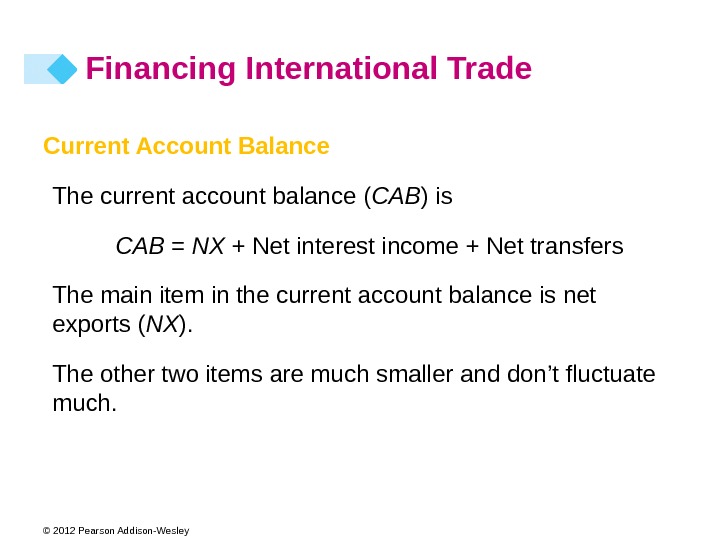
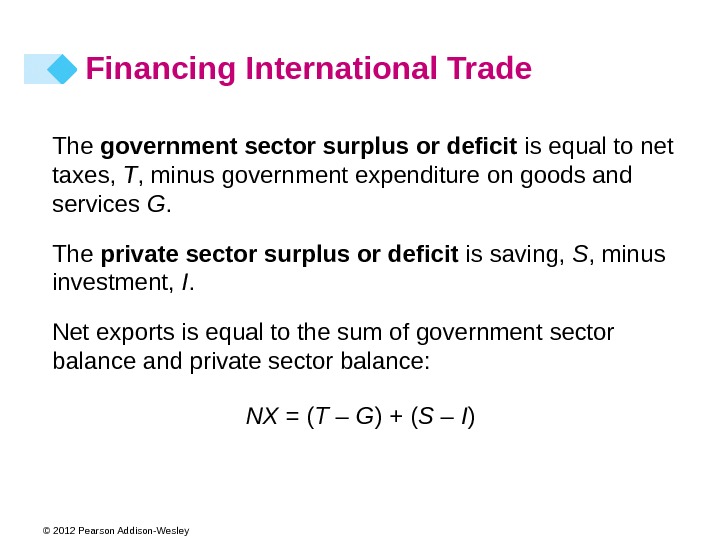
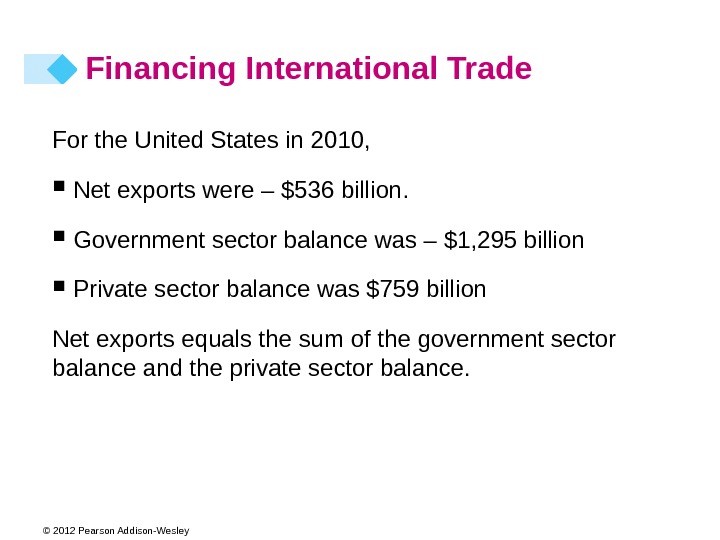
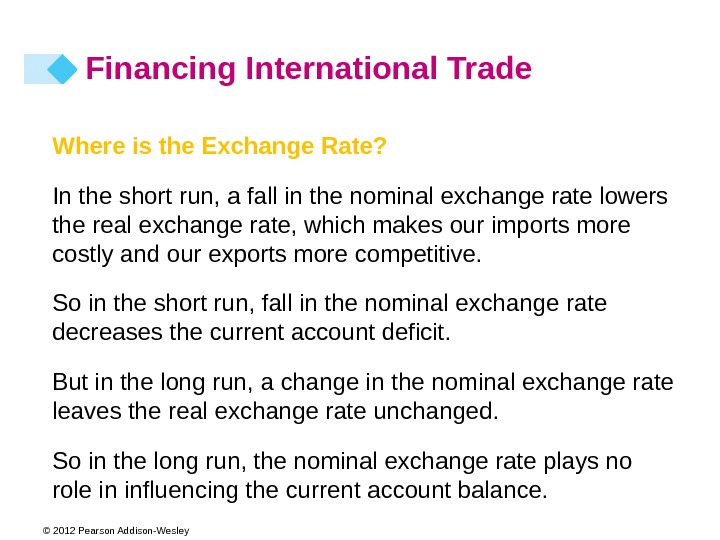
- Размер: 1.6 Mегабайта
- Количество слайдов: 54
Описание презентации Презентация Week 9 Exchange rate and BOP по слайдам

 9 THE EXCHANGE RATE AND THE BALANCE OF PAYMENTS
9 THE EXCHANGE RATE AND THE BALANCE OF PAYMENTS
 © 2012 Pearson Addison-Wesley
© 2012 Pearson Addison-Wesley
 © 2012 Pearson Addison-Wesley The dollar, the yen, and the euro are three of the world’s monies. In October 2000, one U. S. dollar bought 1. 17 euros. From 2000 through 2008, the dollar sank against the euro and by July 2008 one U. S. dollar bought only 0. 63 euros. Why did the dollar fall against the euro? Should the United States do anything to stabilize the foreign exchange value of the dollar? The U. S. economy has become attractive to foreign investors. What determines the amount of international borrowing and lending?
© 2012 Pearson Addison-Wesley The dollar, the yen, and the euro are three of the world’s monies. In October 2000, one U. S. dollar bought 1. 17 euros. From 2000 through 2008, the dollar sank against the euro and by July 2008 one U. S. dollar bought only 0. 63 euros. Why did the dollar fall against the euro? Should the United States do anything to stabilize the foreign exchange value of the dollar? The U. S. economy has become attractive to foreign investors. What determines the amount of international borrowing and lending?
 © 2012 Pearson Addison-Wesley The Foreign Exchange Market To buy goods and services produced in another country we need money of that country. Foreign bank notes, coins, and bank deposits are called foreign currency. We get foreign currency in the foreign exchange market.
© 2012 Pearson Addison-Wesley The Foreign Exchange Market To buy goods and services produced in another country we need money of that country. Foreign bank notes, coins, and bank deposits are called foreign currency. We get foreign currency in the foreign exchange market.
 © 2012 Pearson Addison-Wesley Trading Currencies We get foreign currency and foreigners get U. S dollars in the foreign exchange market. The foreign exchange market is the market in which the currency of one country is exchanged for the currency of another. The foreign exchange market is made up thousands of people- importers, exporters, banks, international travelers, and special traders called foreign exchange brokers. The Foreign Exchange Market
© 2012 Pearson Addison-Wesley Trading Currencies We get foreign currency and foreigners get U. S dollars in the foreign exchange market. The foreign exchange market is the market in which the currency of one country is exchanged for the currency of another. The foreign exchange market is made up thousands of people- importers, exporters, banks, international travelers, and special traders called foreign exchange brokers. The Foreign Exchange Market
 © 2012 Pearson Addison-Wesley Exchange Rates The price at which one currency exchanges for another is called a foreign exchange rate. A fall in the value of one currency in terms of another currency is called currency depreciation. A rise in value of one currency in terms of another currency is called currency appreciation. The Foreign Exchange Market
© 2012 Pearson Addison-Wesley Exchange Rates The price at which one currency exchanges for another is called a foreign exchange rate. A fall in the value of one currency in terms of another currency is called currency depreciation. A rise in value of one currency in terms of another currency is called currency appreciation. The Foreign Exchange Market
 © 2012 Pearson Addison-Wesley An Exchange Rate Is a Price An exchange rate is the price—the price of one currency in terms of another. Like all prices, an exchange rate is determined in a market —the foreign exchange market. The U. S. dollar is demanded and supplied by thousands of traders every hour of every day. With many traders and no restrictions, the foreign exchange market is a competitive market. The Foreign Exchange Market
© 2012 Pearson Addison-Wesley An Exchange Rate Is a Price An exchange rate is the price—the price of one currency in terms of another. Like all prices, an exchange rate is determined in a market —the foreign exchange market. The U. S. dollar is demanded and supplied by thousands of traders every hour of every day. With many traders and no restrictions, the foreign exchange market is a competitive market. The Foreign Exchange Market
 © 2012 Pearson Addison-Wesley The Foreign Exchange Market The Demand for One Money Is the Supply of Another Money When people who are holding one money want to exchange it for U. S. dollars, they demand U. S. dollars and they supply that other country’s money. So the factors that influence the demand for U. S. dollars also influence the supply of Canadian dollars, E. U. euros, U. K. pounds, and Japanese yen. And the factors that influence the demand for another country’s money also influence the supply of U. S. dollars.
© 2012 Pearson Addison-Wesley The Foreign Exchange Market The Demand for One Money Is the Supply of Another Money When people who are holding one money want to exchange it for U. S. dollars, they demand U. S. dollars and they supply that other country’s money. So the factors that influence the demand for U. S. dollars also influence the supply of Canadian dollars, E. U. euros, U. K. pounds, and Japanese yen. And the factors that influence the demand for another country’s money also influence the supply of U. S. dollars.
 © 2012 Pearson Addison-Wesley Demand in the Foreign Exchange Market The quantity of U. S. dollars that traders plan to buy in the foreign exchange market during a given period depends on 1. The exchange rate 2. World demand for U. S. exports 3. Interest rates in the United States and other countries 4. The expected future exchange rate The Foreign Exchange Market
© 2012 Pearson Addison-Wesley Demand in the Foreign Exchange Market The quantity of U. S. dollars that traders plan to buy in the foreign exchange market during a given period depends on 1. The exchange rate 2. World demand for U. S. exports 3. Interest rates in the United States and other countries 4. The expected future exchange rate The Foreign Exchange Market
 © 2012 Pearson Addison-Wesley The Law of Demand for Foreign Exchange The demand for dollars is a derived demand. People buy U. S. dollars so that they can buy U. S. -produced goods and services or U. S. assets. Other things remaining the same, the higher the exchange rate, the smaller is the quantity of U. S. dollars demanded in the foreign exchange market. The Foreign Exchange Market
© 2012 Pearson Addison-Wesley The Law of Demand for Foreign Exchange The demand for dollars is a derived demand. People buy U. S. dollars so that they can buy U. S. -produced goods and services or U. S. assets. Other things remaining the same, the higher the exchange rate, the smaller is the quantity of U. S. dollars demanded in the foreign exchange market. The Foreign Exchange Market
 © 2012 Pearson Addison-Wesley The exchange rate influences the quantity of U. S. dollars demanded for two reasons: Exports effect Expected profit effect Exports Effect The larger the value of U. S. exports, the greater is the quantity of U. S. dollars demanded on the foreign exchange market. The lower the exchange rate, the greater is the value of U. S. exports, so the greater is the quantity of U. S. dollars demanded. The Foreign Exchange Market
© 2012 Pearson Addison-Wesley The exchange rate influences the quantity of U. S. dollars demanded for two reasons: Exports effect Expected profit effect Exports Effect The larger the value of U. S. exports, the greater is the quantity of U. S. dollars demanded on the foreign exchange market. The lower the exchange rate, the greater is the value of U. S. exports, so the greater is the quantity of U. S. dollars demanded. The Foreign Exchange Market
 © 2012 Pearson Addison-Wesley Expected Profit Effect The larger the expected profit from holding U. S. dollars, the greater is the quantity of U. S. dollars demanded today. But expected profit depends on the exchange rate. The lower today’s exchange rate, other things remaining the same, the larger is the expected profit from buying U. S. dollars and the greater is the quantity of U. S. dollars demanded today. The Foreign Exchange Market
© 2012 Pearson Addison-Wesley Expected Profit Effect The larger the expected profit from holding U. S. dollars, the greater is the quantity of U. S. dollars demanded today. But expected profit depends on the exchange rate. The lower today’s exchange rate, other things remaining the same, the larger is the expected profit from buying U. S. dollars and the greater is the quantity of U. S. dollars demanded today. The Foreign Exchange Market
 © 2012 Pearson Addison-Wesley The Demand Curve for U. S. Dollars Figure 9. 1 illustrates the demand curve for U. S. dollars on the foreign exchange market. The Foreign Exchange Market
© 2012 Pearson Addison-Wesley The Demand Curve for U. S. Dollars Figure 9. 1 illustrates the demand curve for U. S. dollars on the foreign exchange market. The Foreign Exchange Market
 © 2012 Pearson Addison-Wesley Supply in the Foreign Exchange Market The quantity of U. S. dollars supplied in the foreign exchange market is the amount that traders plan to sell during a given time period at a given exchange rate. This quantity depends on many factors but the main ones are 1. The exchange rate 2. U. S. demand for imports 3. Interest rates in the United States and other countries 4. The expected future exchange rate The Foreign Exchange Market
© 2012 Pearson Addison-Wesley Supply in the Foreign Exchange Market The quantity of U. S. dollars supplied in the foreign exchange market is the amount that traders plan to sell during a given time period at a given exchange rate. This quantity depends on many factors but the main ones are 1. The exchange rate 2. U. S. demand for imports 3. Interest rates in the United States and other countries 4. The expected future exchange rate The Foreign Exchange Market
 © 2012 Pearson Addison-Wesley. The Law of Supply of Foreign Exchange Other things remaining the same, the higher the exchange rate, the greater is the quantity of U. S. dollars supplied in the foreign exchange market. The exchange rate influences the quantity of U. S. dollars supplied for two reasons: Imports effect Expected profit effect The Foreign Exchange Market
© 2012 Pearson Addison-Wesley. The Law of Supply of Foreign Exchange Other things remaining the same, the higher the exchange rate, the greater is the quantity of U. S. dollars supplied in the foreign exchange market. The exchange rate influences the quantity of U. S. dollars supplied for two reasons: Imports effect Expected profit effect The Foreign Exchange Market
 © 2012 Pearson Addison-Wesley Imports Effect The larger the value of U. S. imports, the larger is the quantity of U. S. dollars supplied on the foreign exchange market. The higher the exchange rate, the greater is the value of U. S. imports, so the greater is the quantity of U. S. dollars supplied. The Foreign Exchange Market
© 2012 Pearson Addison-Wesley Imports Effect The larger the value of U. S. imports, the larger is the quantity of U. S. dollars supplied on the foreign exchange market. The higher the exchange rate, the greater is the value of U. S. imports, so the greater is the quantity of U. S. dollars supplied. The Foreign Exchange Market
 © 2012 Pearson Addison-Wesley Expected Profit Effect For a given expected future U. S. dollar exchange rate, the lower the current exchange rate, the greater is the expected profit from holding U. S. dollars, and the smaller is the quantity of U. S. dollars supplied on the foreign exchange market. The Foreign Exchange Market
© 2012 Pearson Addison-Wesley Expected Profit Effect For a given expected future U. S. dollar exchange rate, the lower the current exchange rate, the greater is the expected profit from holding U. S. dollars, and the smaller is the quantity of U. S. dollars supplied on the foreign exchange market. The Foreign Exchange Market
 © 2012 Pearson Addison-Wesley Supply Curve for U. S. Dollars Figure 9. 2 illustrates the supply curve of U. S. dollars in the foreign exchange market. The Foreign Exchange Market
© 2012 Pearson Addison-Wesley Supply Curve for U. S. Dollars Figure 9. 2 illustrates the supply curve of U. S. dollars in the foreign exchange market. The Foreign Exchange Market
 © 2012 Pearson Addison-Wesley Market Equilibrium Figure 9. 3 shows how demand supply in the foreign exchange market determine the exchange rate. The Foreign Exchange Market
© 2012 Pearson Addison-Wesley Market Equilibrium Figure 9. 3 shows how demand supply in the foreign exchange market determine the exchange rate. The Foreign Exchange Market
 © 2012 Pearson Addison-Wesley If the exchange rate is too high, a surplus of U. S. dollars drives it down. If the exchange rate is too low, a shortage of U. S. dollars drives it up. The market is pulled (quickly) to the equilibrium exchange rate at which there is neither a shortage nor a surplus. The Foreign Exchange Market
© 2012 Pearson Addison-Wesley If the exchange rate is too high, a surplus of U. S. dollars drives it down. If the exchange rate is too low, a shortage of U. S. dollars drives it up. The market is pulled (quickly) to the equilibrium exchange rate at which there is neither a shortage nor a surplus. The Foreign Exchange Market
 © 2012 Pearson Addison-Wesley Exchange Rate Fluctuations Changes in the Demand for U. S. Dollars A change in any influence on the quantity of U. S. dollars that people plan to buy, other than the exchange rate, brings a change in the demand for U. S. dollars. These other influences are World demand for U. S. exports U. S. interest rate relative to the foreign interest rate The expected future exchange rate
© 2012 Pearson Addison-Wesley Exchange Rate Fluctuations Changes in the Demand for U. S. Dollars A change in any influence on the quantity of U. S. dollars that people plan to buy, other than the exchange rate, brings a change in the demand for U. S. dollars. These other influences are World demand for U. S. exports U. S. interest rate relative to the foreign interest rate The expected future exchange rate
 © 2012 Pearson Addison-Wesley World Demand for U. S. Exports At a given exchange rate, if world demand for U. S. exports increases, the demand for U. S. dollars increases and the demand curve for U. S. dollars shifts rightward. U. S. Interest Rate Relative to the Foreign Interest Rate The U. S. interest rate minus the foreign interest rate is called the U. S. interest rate differential. If the U. S. interest differential rises, the demand for U. S. dollars increases and the demand curve for U. S. dollars shifts rightward. Exchange Rate Fluctuations
© 2012 Pearson Addison-Wesley World Demand for U. S. Exports At a given exchange rate, if world demand for U. S. exports increases, the demand for U. S. dollars increases and the demand curve for U. S. dollars shifts rightward. U. S. Interest Rate Relative to the Foreign Interest Rate The U. S. interest rate minus the foreign interest rate is called the U. S. interest rate differential. If the U. S. interest differential rises, the demand for U. S. dollars increases and the demand curve for U. S. dollars shifts rightward. Exchange Rate Fluctuations
 © 2012 Pearson Addison-Wesley The Expected Future Exchange Rate At a given current exchange rate, if the expected future exchange rate for U. S. dollars rises, the demand for U. S. dollars increases and the demand curve for dollars shifts rightward. Exchange Rate Fluctuations
© 2012 Pearson Addison-Wesley The Expected Future Exchange Rate At a given current exchange rate, if the expected future exchange rate for U. S. dollars rises, the demand for U. S. dollars increases and the demand curve for dollars shifts rightward. Exchange Rate Fluctuations
 © 2012 Pearson Addison-Wesley Figure 9. 4 shows how the demand curve for U. S. dollars shifts in response to changes in U. S. exports The U. S. interest rate differential The expected future exchange rate Exchange Rate Fluctuations
© 2012 Pearson Addison-Wesley Figure 9. 4 shows how the demand curve for U. S. dollars shifts in response to changes in U. S. exports The U. S. interest rate differential The expected future exchange rate Exchange Rate Fluctuations
 © 2012 Pearson Addison-Wesley Changes in the Supply of Dollars A change in any influence on the quantity of U. S. dollars that people plan to sell, other than the exchange rate, brings a change in the supply of dollars. These other influences are U. S. demand for imports U. S. interest rates relative to the foreign interest rate The expected future exchange rate Exchange Rate Fluctuations
© 2012 Pearson Addison-Wesley Changes in the Supply of Dollars A change in any influence on the quantity of U. S. dollars that people plan to sell, other than the exchange rate, brings a change in the supply of dollars. These other influences are U. S. demand for imports U. S. interest rates relative to the foreign interest rate The expected future exchange rate Exchange Rate Fluctuations
 © 2012 Pearson Addison-Wesley U. S. Demand for Imports At a given exchange rate, if the U. S. demand for imports increases, the supply of U. S. dollars on the foreign exchange market increases and the supply curve of U. S. dollars shifts rightward. U. S. Interest Rate Relative to the Foreign Interest Rate If the U. S. interest differential rises, the supply for U. S. dollars decreases and the supply curve of U. S. dollars shifts leftward. Exchange Rate Fluctuations
© 2012 Pearson Addison-Wesley U. S. Demand for Imports At a given exchange rate, if the U. S. demand for imports increases, the supply of U. S. dollars on the foreign exchange market increases and the supply curve of U. S. dollars shifts rightward. U. S. Interest Rate Relative to the Foreign Interest Rate If the U. S. interest differential rises, the supply for U. S. dollars decreases and the supply curve of U. S. dollars shifts leftward. Exchange Rate Fluctuations
 © 2012 Pearson Addison-Wesley The Expected Future Exchange Rate At a given current exchange rate, if the expected future exchange rate for U. S. dollars rises, the supply of U. S. dollars decreases and the demand curve for dollars shifts leftward. Exchange Rate Fluctuations
© 2012 Pearson Addison-Wesley The Expected Future Exchange Rate At a given current exchange rate, if the expected future exchange rate for U. S. dollars rises, the supply of U. S. dollars decreases and the demand curve for dollars shifts leftward. Exchange Rate Fluctuations
 © 2012 Pearson Addison-Wesley Figure 9. 5 shows how the supply curve of U. S. dollars shifts in response to changes in U. S. demand for imports The U. S. interest rate differential The expected future exchange rate Exchange Rate Fluctuations
© 2012 Pearson Addison-Wesley Figure 9. 5 shows how the supply curve of U. S. dollars shifts in response to changes in U. S. demand for imports The U. S. interest rate differential The expected future exchange rate Exchange Rate Fluctuations
 © 2012 Pearson Addison-Wesley Changes in the Exchange Rate If demand for U. S. dollars increases and supply does not change, the exchange rate rises. If demand for U. S. dollars decreases and supply does not change, the exchange rate falls. If supply of U. S. dollars increases and demand does not change, the exchange rate falls. If supply of U. S. dollars decreases and demand does not change, the exchange rate rises. Exchange Rate Fluctuations
© 2012 Pearson Addison-Wesley Changes in the Exchange Rate If demand for U. S. dollars increases and supply does not change, the exchange rate rises. If demand for U. S. dollars decreases and supply does not change, the exchange rate falls. If supply of U. S. dollars increases and demand does not change, the exchange rate falls. If supply of U. S. dollars decreases and demand does not change, the exchange rate rises. Exchange Rate Fluctuations
 © 2012 Pearson Addison-Wesley Fundamentals, Expectations, and Arbitrage The exchange rate changes when it is expected to change. But expectations about the exchange rate are driven by deeper forces. Two such forces are Interest rate parity Purchasing power parity Exchange Rate Fluctuations
© 2012 Pearson Addison-Wesley Fundamentals, Expectations, and Arbitrage The exchange rate changes when it is expected to change. But expectations about the exchange rate are driven by deeper forces. Two such forces are Interest rate parity Purchasing power parity Exchange Rate Fluctuations
 © 2012 Pearson Addison-Wesley Interest Rate Parity A currency is worth what it can earn. The return on a currency is the interest rate on that currency plus the expected rate of appreciation over a given period. When the rates of returns on two currencies are equal, interest rate parity prevails. Interest rate parity means equal interest rates when exchange rate changes are taken into account. Market forces achieve interest rate parity very quickly. Exchange Rate Fluctuations
© 2012 Pearson Addison-Wesley Interest Rate Parity A currency is worth what it can earn. The return on a currency is the interest rate on that currency plus the expected rate of appreciation over a given period. When the rates of returns on two currencies are equal, interest rate parity prevails. Interest rate parity means equal interest rates when exchange rate changes are taken into account. Market forces achieve interest rate parity very quickly. Exchange Rate Fluctuations
 © 2012 Pearson Addison-Wesley Purchasing Power Parity A currency is worth the value of goods and services that it will buy. The quantity of goods and services that one unit of a particular currency will buy differs from the quantity of goods and services that one unit of another currency will buy. When two quantities of money can buy the same quantity of goods and services, the situation is called purchasing power parity , which means equal value of money. Exchange Rate Fluctuations
© 2012 Pearson Addison-Wesley Purchasing Power Parity A currency is worth the value of goods and services that it will buy. The quantity of goods and services that one unit of a particular currency will buy differs from the quantity of goods and services that one unit of another currency will buy. When two quantities of money can buy the same quantity of goods and services, the situation is called purchasing power parity , which means equal value of money. Exchange Rate Fluctuations
 © 2012 Pearson Addison-Wesley Instant Exchange Rate Response The exchange rate responds instantly to news about changes in the variables that influence demand supply in the foreign exchange market. Suppose that the Bank of Japan is considering raising the interest rate next week. With this news, currency traders expect the demand for yen to increase and the demand for dollars to decrease— they expect the U. S. dollar to depreciate. Exchange Rate Fluctuations
© 2012 Pearson Addison-Wesley Instant Exchange Rate Response The exchange rate responds instantly to news about changes in the variables that influence demand supply in the foreign exchange market. Suppose that the Bank of Japan is considering raising the interest rate next week. With this news, currency traders expect the demand for yen to increase and the demand for dollars to decrease— they expect the U. S. dollar to depreciate. Exchange Rate Fluctuations
 © 2012 Pearson Addison-Wesley But to benefit from a yen appreciation, yen must be bought and dollars must be sold before the exchange rate changes. Each trader knows that all the other traders share the same information and have similar expectations. Each trader knows that when people begin to sell dollars and buy yen, the exchange rate will change. To transact before the exchange rate changes means transacting right away, as soon as the news is received. Exchange Rate Fluctuations
© 2012 Pearson Addison-Wesley But to benefit from a yen appreciation, yen must be bought and dollars must be sold before the exchange rate changes. Each trader knows that all the other traders share the same information and have similar expectations. Each trader knows that when people begin to sell dollars and buy yen, the exchange rate will change. To transact before the exchange rate changes means transacting right away, as soon as the news is received. Exchange Rate Fluctuations
 © 2012 Pearson Addison-Wesley The Real Exchange Rate The real exchange rate is the relative price of U. S. -produced goods and services to foreign-produced goods and services. It measures the quantity of real GDP of other countries that a unit of U. S. real GDP buys. The equation that links the nominal exchange rate ( E ) and real exchange rate ( RER ) is RER = ( E x P) / P * where P is the U. S. price level and P * is the Japanese price level. Exchange Rate Fluctuations
© 2012 Pearson Addison-Wesley The Real Exchange Rate The real exchange rate is the relative price of U. S. -produced goods and services to foreign-produced goods and services. It measures the quantity of real GDP of other countries that a unit of U. S. real GDP buys. The equation that links the nominal exchange rate ( E ) and real exchange rate ( RER ) is RER = ( E x P) / P * where P is the U. S. price level and P * is the Japanese price level. Exchange Rate Fluctuations
 © 2012 Pearson Addison-Wesley The Short Run In the short run, the equation determines RER = ( E x P) / P * In the short run, if the nominal exchange rate changes, P and P * do not change and the change in E brings an equivalent change in RER. Exchange Rate Fluctuations
© 2012 Pearson Addison-Wesley The Short Run In the short run, the equation determines RER = ( E x P) / P * In the short run, if the nominal exchange rate changes, P and P * do not change and the change in E brings an equivalent change in RER. Exchange Rate Fluctuations
 © 2012 Pearson Addison-Wesley The Long Run In the long run, RER is determined by the real forces of demand supply in the markets for goods and services. So in the long run, E is determined by RER and the price levels. That is, E = RER x ( P* / P ) A rise in the Japanese price level P * brings an appreciation of the U. S. dollar in the long run. A rise in the U. S. price level P brings a depreciation of the U. S. dollar in the long run. Exchange Rate Fluctuations
© 2012 Pearson Addison-Wesley The Long Run In the long run, RER is determined by the real forces of demand supply in the markets for goods and services. So in the long run, E is determined by RER and the price levels. That is, E = RER x ( P* / P ) A rise in the Japanese price level P * brings an appreciation of the U. S. dollar in the long run. A rise in the U. S. price level P brings a depreciation of the U. S. dollar in the long run. Exchange Rate Fluctuations
 © 2012 Pearson Addison-Wesley Exchange Rate Policy Three possible exchange rate policies are Flexible exchange rate Fixed exchange rate Crawling peg Flexible Exchange Rate A flexible exchange rate policy is one that permits the exchange rate to be determined by demand supply with no direct intervention in the foreign exchange market by the central bank.
© 2012 Pearson Addison-Wesley Exchange Rate Policy Three possible exchange rate policies are Flexible exchange rate Fixed exchange rate Crawling peg Flexible Exchange Rate A flexible exchange rate policy is one that permits the exchange rate to be determined by demand supply with no direct intervention in the foreign exchange market by the central bank.
 © 2012 Pearson Addison-Wesley Fixed Exchange Rate A fixed exchange rate policy is one that pegs the exchange rate at a value decided by the government or central bank and is achieved by direct intervention in the foreign exchange market to block unregulated forces of demand supply. A fixed exchange rate requires active intervention in the foreign exchange market. Exchange Rate Policy
© 2012 Pearson Addison-Wesley Fixed Exchange Rate A fixed exchange rate policy is one that pegs the exchange rate at a value decided by the government or central bank and is achieved by direct intervention in the foreign exchange market to block unregulated forces of demand supply. A fixed exchange rate requires active intervention in the foreign exchange market. Exchange Rate Policy
 © 2012 Pearson Addison-Wesley Exchange Rate Policy Figure 9. 6 shows how the Fed can intervene in the foreign exchange market to keep the exchange rate close to a target rate. Suppose that the target is 100 yen per U. S. dollar. If the demand for U. S. dollars increases, the Fed sells U. S. dollars to increase supply.
© 2012 Pearson Addison-Wesley Exchange Rate Policy Figure 9. 6 shows how the Fed can intervene in the foreign exchange market to keep the exchange rate close to a target rate. Suppose that the target is 100 yen per U. S. dollar. If the demand for U. S. dollars increases, the Fed sells U. S. dollars to increase supply.
 © 2012 Pearson Addison-Wesley If demand for the U. S. dollar decreases, the Fed buys U. S. dollars to decrease supply. Persistent intervention on one side of the foreign exchange market cannot be sustained. Exchange Rate Policy
© 2012 Pearson Addison-Wesley If demand for the U. S. dollar decreases, the Fed buys U. S. dollars to decrease supply. Persistent intervention on one side of the foreign exchange market cannot be sustained. Exchange Rate Policy
 © 2012 Pearson Addison-Wesley Crawling Peg A crawling peg is an exchange rate that follows a path determined by a decision of the government or the central bank and is achieved by active intervention in the market. China is a country that operates a crawling peg. A crawling peg works like a fixed exchange rate except that the target value changes. The idea behind a crawling peg is to avoid wild swings in the exchange rate that might happen if expectations became volatile and to avoid the problem of running out of reserves, which can happen with a fixed exchange rate. Exchange Rate Policy
© 2012 Pearson Addison-Wesley Crawling Peg A crawling peg is an exchange rate that follows a path determined by a decision of the government or the central bank and is achieved by active intervention in the market. China is a country that operates a crawling peg. A crawling peg works like a fixed exchange rate except that the target value changes. The idea behind a crawling peg is to avoid wild swings in the exchange rate that might happen if expectations became volatile and to avoid the problem of running out of reserves, which can happen with a fixed exchange rate. Exchange Rate Policy
 © 2012 Pearson Addison-Wesley Financing International Trade We’ve seen how the exchange rate is determined, but what is the effect of the exchange rate? How does currency appreciation or depreciation influence U. S. international trade? We record international transactions in the balance of payments accounts.
© 2012 Pearson Addison-Wesley Financing International Trade We’ve seen how the exchange rate is determined, but what is the effect of the exchange rate? How does currency appreciation or depreciation influence U. S. international trade? We record international transactions in the balance of payments accounts.
 © 2012 Pearson Addison-Wesley Financing International Trade Balance of Payments Accounts A country’s balance of payments accounts records its international trading, borrowing, and lending. There are three balance of payments accounts: 1. Current account 2. Capital and financial account 3. Official settlements account
© 2012 Pearson Addison-Wesley Financing International Trade Balance of Payments Accounts A country’s balance of payments accounts records its international trading, borrowing, and lending. There are three balance of payments accounts: 1. Current account 2. Capital and financial account 3. Official settlements account
 © 2012 Pearson Addison-Wesley The current account records receipts from exports of goods and services sold abroad, payments for imports of goods and services from abroad, net interest paid abroad, and net transfers (such as foreign aid payments). The current accounts balance = exports — imports + net interest income + net transfers. Financing International Trade
© 2012 Pearson Addison-Wesley The current account records receipts from exports of goods and services sold abroad, payments for imports of goods and services from abroad, net interest paid abroad, and net transfers (such as foreign aid payments). The current accounts balance = exports — imports + net interest income + net transfers. Financing International Trade
 © 2012 Pearson Addison-Wesley The capital and financial account records foreign investment in the United States minus U. S. investment abroad. The official settlements account records the change in U. S. official reserves are the government’s holdings of foreign currency. If U. S. official reserves increase , the official settlements account is negative. The sum of the balances of the three accounts always equals zero. Financing International Trade
© 2012 Pearson Addison-Wesley The capital and financial account records foreign investment in the United States minus U. S. investment abroad. The official settlements account records the change in U. S. official reserves are the government’s holdings of foreign currency. If U. S. official reserves increase , the official settlements account is negative. The sum of the balances of the three accounts always equals zero. Financing International Trade
 © 2012 Pearson Addison-Wesley Borrowers and Lenders A country that is borrowing more from the rest of the world than it is lending to it is called a net borrower. A country that is lending more to the rest of the world than it is borrowing from it is called a net lender. Since the early 1980 s, except for 1991, the United States has been a net borrower from the rest of the world. In 2010, The United States borrowed more than $400 billion from the rest of the world, most from China. Financing International Trade
© 2012 Pearson Addison-Wesley Borrowers and Lenders A country that is borrowing more from the rest of the world than it is lending to it is called a net borrower. A country that is lending more to the rest of the world than it is borrowing from it is called a net lender. Since the early 1980 s, except for 1991, the United States has been a net borrower from the rest of the world. In 2010, The United States borrowed more than $400 billion from the rest of the world, most from China. Financing International Trade
 © 2012 Pearson Addison-Wesley. Debtors and Creditors A debtor nation is a country that during its entire history has borrowed more from the rest of the world than it has lent to it. Since 1986, the United States has been a debtor nation. A creditor nation is a country that has invested more in the rest of the world than other countries have invested in it. The difference between being a borrower/lender nation and being a creditor/debtor nation is the difference between stocks and flows of financial capital. Financing International Trade
© 2012 Pearson Addison-Wesley. Debtors and Creditors A debtor nation is a country that during its entire history has borrowed more from the rest of the world than it has lent to it. Since 1986, the United States has been a debtor nation. A creditor nation is a country that has invested more in the rest of the world than other countries have invested in it. The difference between being a borrower/lender nation and being a creditor/debtor nation is the difference between stocks and flows of financial capital. Financing International Trade
 © 2012 Pearson Addison-Wesley Being a net borrower is not a problem provided the borrowed funds are used to finance capital accumulation that increases income. Being a net borrower is a problem if the borrowed funds are used to finance consumption. Financing International Trade
© 2012 Pearson Addison-Wesley Being a net borrower is not a problem provided the borrowed funds are used to finance capital accumulation that increases income. Being a net borrower is a problem if the borrowed funds are used to finance consumption. Financing International Trade
 © 2012 Pearson Addison-Wesley Current Account Balance The current account balance ( CAB ) is CAB = NX + Net interest income + Net transfers The main item in the current account balance is net exports ( NX ). The other two items are much smaller and don’t fluctuate much. Financing International Trade
© 2012 Pearson Addison-Wesley Current Account Balance The current account balance ( CAB ) is CAB = NX + Net interest income + Net transfers The main item in the current account balance is net exports ( NX ). The other two items are much smaller and don’t fluctuate much. Financing International Trade
 © 2012 Pearson Addison-Wesley The government sector surplus or deficit is equal to net taxes, T , minus government expenditure on goods and services G. The private sector surplus or deficit is saving, S , minus investment, I. Net exports is equal to the sum of government sector balance and private sector balance: NX = ( T – G ) + ( S – I ) Financing International Trade
© 2012 Pearson Addison-Wesley The government sector surplus or deficit is equal to net taxes, T , minus government expenditure on goods and services G. The private sector surplus or deficit is saving, S , minus investment, I. Net exports is equal to the sum of government sector balance and private sector balance: NX = ( T – G ) + ( S – I ) Financing International Trade
 © 2012 Pearson Addison-Wesley For the United States in 2010, Net exports were – $536 billion. Government sector balance was – $1, 295 billion Private sector balance was $759 billion Net exports equals the sum of the government sector balance and the private sector balance. Financing International Trade
© 2012 Pearson Addison-Wesley For the United States in 2010, Net exports were – $536 billion. Government sector balance was – $1, 295 billion Private sector balance was $759 billion Net exports equals the sum of the government sector balance and the private sector balance. Financing International Trade
 © 2012 Pearson Addison-Wesley Where is the Exchange Rate? In the short run, a fall in the nominal exchange rate lowers the real exchange rate, which makes our imports more costly and our exports more competitive. So in the short run, fall in the nominal exchange rate decreases the current account deficit. But in the long run, a change in the nominal exchange rate leaves the real exchange rate unchanged. So in the long run, the nominal exchange rate plays no role in influencing the current account balance. Financing International Trade
© 2012 Pearson Addison-Wesley Where is the Exchange Rate? In the short run, a fall in the nominal exchange rate lowers the real exchange rate, which makes our imports more costly and our exports more competitive. So in the short run, fall in the nominal exchange rate decreases the current account deficit. But in the long run, a change in the nominal exchange rate leaves the real exchange rate unchanged. So in the long run, the nominal exchange rate plays no role in influencing the current account balance. Financing International Trade

